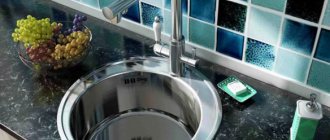Which material is better
Some time ago, buying a stainless steel sink was incredibly lucky. Mostly enameled ones were used. The idea, of course, is not bad, but the execution was extremely poor. Today there are a lot of options:
- Stainless steel. It may or may not be polished. The most durable option, easy to clean. But a polished stainless steel sink will eventually become covered with a network of scratches and lose its appearance. Unpolished ones look good, but cost more. Well, the main drawback is the noise when a stream of water falls. To make the sink “quieter,” a layer of soundproofing material is glued to the bottom.
- Copper. These are not cheap options at all. Suitable for special kitchen interiors. Difficult to care for (requires special products) and is not widespread.
Metal kitchen sinks: copper and stainless steel without wings - Made from artificial stone. The natural component (stone chips and quartz sand) is diluted with a polymer binder, and the resulting composition is poured into molds. This is how you get a stone sink. There are different types of material: based on granite, quartz, marble, quartz sand. They are usually named after the “stone” component: granite, marble, quartz kitchen sink. Some companies develop special compositions, but they differ in the polymer binder, which gives the product certain performance properties (for example, Silgranit from the German company Blanco).
Stone and glass (glass top) sinks are a more modern choice - Ceramic. Ceramics - porcelain or earthenware - are not so popular for kitchen sinks, but they are also available.
There are those that appeared not so long ago - with a glass panel (pictured on the left). This is a stainless steel sink with a tempered glass surface. This option will look great next to a hob of the same color. And don't be afraid that the glass will crack. It has been hardened, so it is difficult to damage it.
Sink installation options
Before you buy a sink, you will need to decide on its installation method. Often one of the following options is used:
- mortise Preliminary slots are made in the countertop into which the sink is inserted. The joints are sealed with sealants. This type of installation is the most convenient and is used more often than others. Any material is suitable for the countertop;
- invoice. Installation is carried out on a separate bedside table, which is often slightly smaller in height than the main tabletop. Used in cases where furniture consists of separate parts. Installation is very simple, easy to do yourself. The disadvantages include water getting into the gap between the sink and the cabinet;
- integrated. The installation is used quite rarely; installation experience and a lot of money are required to carry out the work. The sink cuts into the countertop, due to which a single whole appears with it. This option is suitable for stone or composite countertops, but this type is not suitable for wood, chipboard and similar materials;
- under-table. This type of installation involves installing the sink below the countertop. This option is suitable if the working part is made of composite materials, stone or plastic. The sink will not stand out against the background of the countertop; it emphasizes the style of the kitchen and this option is very convenient to use.
When selecting a product based on the type of installation, there are no special recommendations; each owner independently decides and decides on the installation.
Stainless steel or stone?
It is usually difficult to decide which is better: a stainless steel or stone kitchen sink. Let's first talk about the advantages of each type. Stainless steel is not afraid of shock loads, is easy to clean, and has a long service life. Stone kitchen sinks are quiet, come in different colors, and have a wider selection of shapes.
To decide which kitchen sink is better - artificial stone or stainless steel, you need to know the pros and cons of both materials
Now about the disadvantages. Stainless steel: noisy, there are only two color options, polished steel gets scratched and it’s impossible to remove scratches. If there is a high salt content in the water, stains remain on the polished surface. So, in order for your sink to look neat, you need to take care of it. Inexpensive sinks made from stone chips require careful handling: scratches and chips may occur. Some - light - may turn yellow or darken over time. The problem can be solved by cleaning, but it can be annoying. If the content of stone chips or quartz is low, an artificial stone sink may be afraid of high temperatures. So that you don’t care, just make sure the product is of normal quality.
How critical are chips and scratches on granite sinks?
You should not drop anything heavy into them. No, nothing will happen from a dropped cup or plate. The dishes will break, but the sink will most likely remain as it was. A small chip may appear, depending on how and where it falls. But if you drop a heavy pot or frying pan, you can expect it to chip with a high probability.
The ability to choose colors is very important when creating an interior
The good news is that scratches can be sanded out. For this, sometimes the abrasive part of a sponge is enough, sometimes you need to use fine-grain sandpaper. The degree of polishing depends on the quality of the material from which the sink is made. If the composition is painted in the mass (the dye is added before molding), it can be sanded to any depth.
A black sink on a black countertop—this was never possible before
Chips on granite, quartz and other composite sinks are also easy to repair. Most of . It is a pigment in powder form and a polymer binder. By mixing a certain amount, you get a repair composition. It is applied to the chipped area and sanded after drying. Often the former chip then takes a long time to look for and may not be found.
Cabinet or cabinet dimensions
To install a sink in the kitchen, you will need a floor cabinet or cabinet where all the wires, pipes, siphons, filters, food waste grinders are placed, and also supplemented with shelves or storage containers.
The cabinet or sink cabinet is made in the same design and has the same height as other furniture. They are often made more durable, since a sink made of stone or ceramics has significant weight.
The most important indicator when choosing a cabinet or cabinet is the distance between its side walls. On top between them there is a bowl or several bowls. Below, inside the cabinet, there are all sewer and water supply equipment.
- For an overhead model, the distance between the side walls of the cabinet should match the width of the sink itself.
- For mortise ones, this size is usually indicated in the installation diagram. There are several standard cabinet widths - 45, 60, 70 and 90 cm.
The standard depth of a kitchen cabinet, like other kitchen furniture, is about 60 cm. Most models are produced taking these values into account.
The standard height of kitchen furniture is 82-85 cm, but people who are taller or shorter than average are often forced to order sink cabinets made to measure.
Sink forms
Choosing a sink for the kitchen is not so easy. There are so many offers that it's easy to get lost. The diversity of species is stunning. Sometimes even the shape is not so easy to decide on, but the shapes of kitchen sinks are:
- Angular. The best option for L and P-shaped kitchen sets. Installing a sink in a corner allows you to make the best use of this space.
Corner sinks - convenient and functional - Rectangular/square. The most common, as they allow you to optimally use the area. They are convenient for washing dishes of any size. The same baking sheets, skewers, etc.
- Round. They seem to be the most original, but in practice they are inconvenient - it is a problem to wash the baking sheet and other large dishes, since the dimensions of the bowl are much smaller. Models without a side table may look good, but they are very inconvenient. In models with a wing, it is usually small in size, which also doesn’t help much.
Oval sinks are very rare - Oval. Quite rare. Most often it is a round sink, complemented by a second bowl or table of the same type next to it. The shape of the “wing” is just oval. And an oval sink bowl is extremely rare.
There is also a type called modular kitchen sinks. They are made of artificial stone and cast immediately with the countertop. This type is made to your measurements, so local companies do this. It is difficult to say how high quality the product will be - it depends on the specific company.
An example of a composite sink - cast immediately with the countertop
If we talk about choosing a shape, then more often, after all, they settle on rectangular or square. In addition to being a classic, they are the most convenient to use.
Even classic square sinks are different in appearance
Only rectangular ones can have more or less rounded corners. Sharp corners look more graphic, but they are more difficult to maintain - it is harder to clean out the dirt that accumulates there.
Which sink is right for your kitchen?
To decide which sink model will best fit into your kitchen design, we’ll make a list of requirements for an ideal sink.
The kitchen sink should be spacious enough. After all, not only plates and cups are usually washed in it, but also pots, pans, baking sheets and other kitchen utensils. A good sink must withstand high temperatures, accidental impacts and exposure to various household chemicals. At the same time, it is easy to use and retains its excellent appearance with a minimum of effort.
You should only take a closer look at the kitchen sink after you have decided on the style of your kitchen. Then it will fit harmoniously into the interior and will be combined with kitchen furniture, appliances and accessories. Be sure to take into account your family's cooking habits—how often you cook, what ingredients you use, and how many dishes you have to wash daily.
Decide in advance what shape of faucet to choose, what items you will keep near the sink, whether to install a water filter and a waste shredder.
Bowls and their varieties
Sometimes the size of the sink is very important - in small kitchens, narrow countertops. In this case, a sink with sides is usually used. It is simply a bowl, along the perimeter or circumference of which there is a thickening or protrusion - a rim. The width of the side is several centimeters.
The second type is a kitchen sink with a work surface - a wing to the right or left of the bowl. Some models are “reversible”, meaning they can be installed either way. Also called a “wash with a wing”. They are interesting because you can lay out washed dishes on the surface, leave food, etc. The draining liquid ends up in the sink.
Kitchen sink with two bowls. Moreover, there are two options:
- both bowls are the same size (can be called a double sink);
- one bowl is larger, the other is noticeably smaller (in size and/or depth).
One and a half sinks - two bowls of different sizes
Two identical bowls can be used to wash dishes faster: one bowl contains soapy water, the other contains clean water for rinsing. The second option is also called a one-and-a-half sink. The second - a smaller vessel is used for defrosting food, for squeezing out excess liquid, etc. You can put a mesh (called a colander) in a shallow bowl, which increases functionality.
There are also kitchen sinks with two bowls and a wing. They are good for large kitchens. In principle, they can be used both under a window and on a long working wall.
Examples of location and design: photo design and video of sink installation
The size of the sink depends on various factors: shape, type, number of bowls, etc. When choosing, you need to pay attention to all aspects. The main thing is to choose one that is convenient for use. There are no objective assessments here, since comfort is understood differently for everyone.
Sources:
- https://kitchendecorium.ru/remont/santehnica/razmeri-kuxonnoj-mojki.html
- https://KuhniClub.ru/santehnika/razmer-mojki-na-kuxne.html
- https://www.Hausdorf.ru/articles/kakikh-razmerov-byvayut-moyki.html
- https://Granfest.ru/stati/vse-o-razmerah-kuhonnoj-mojki
- https://santehnicheskij-mir.ru/rakovina-moika/razmery-mojki-dla-kuhni.html
- https://dekoriko.ru/kuhnya/mojki/razmery/
- https://kitchen-eco.ru/remont/santehnika/kak-podobrat-razmer-kuhonnoj-mojki
- 1
Installation method
There are three ways to install a sink in a countertop:
- Mortise. This is when a bowl-shaped cutout is made in the countertop and a sink is inserted into it. It is held in place by the sides, although there are additional fastenings.
Methods for installing a kitchen sink into a countertop - Under-table installation. Sinks that are attached to the bottom of the countertop. The cutout in the tabletop is made strictly according to the size of the bowl. Moreover, the cut must be processed (edged or polished if the countertop is made of artificial stone).
Sink with under-counter installation in the countertop - On the same level as the countertop. Only certain types of sinks are installed this way. In principle, you can install a regular sink, but to do this you will have to mill a groove in the countertop. And this will have to be done very accurately.
You need to choose the method of installation in the countertop before you decide on the model - each installation has its own design options, its own fasteners, which come with the sink.
How to complement your kitchen sink?
An essential element of an ideal kitchen sink is a drainer or drainer. It can be located on one side of the sink or on both. Its function is to serve as a stand for dishes, food or hot pots and pans.
A modern kitchen sink is a real work center, which includes many additional accessories. They can be sold together with the sink. In this case, they are guaranteed to match it in design and technical parameters. However, you can choose them yourself. Manufacturers often complement “smart” kitchen sinks with waste choppers, sets of knives, graters, baskets for washing and drying vegetables and fruits, soap dispensers, as well as cutting boards, the shape of which follows the contours of the sink. All these devices make the housewife’s life much easier and save precious working space in the kitchen.
Sink dimensions
Since the kitchen sink is installed in the cabinet countertop, it cannot be larger in size. Please note that it is very difficult to find options for cabinets of small depth - less than 60 cm. Unless the sink will only have a side and is for surface mounting.
The kitchen sink can be of different sizes
When choosing a specific model, you must first know the distance between the front and back walls of the cabinet and the dimensions of the countertop. Why both? Because usually the tabletop is larger than the body. In this case, the cutout in the tabletop should be at some distance from the walls of the frame. For under-table mounting and level installation, monitor the following parameters:
- The optimal distance from the back and front walls of the cabinet frame is 5 cm. The distance at the back can be greater - it will be more convenient to maintain cleanliness. If there is a sufficiently large gap between the edge of the sink and the wall, you can install household chemicals, ideally, choose a dispenser to keep everything you need at hand.
- You can place the kitchen sink flush with the back edge of the countertop, but cleaning will be more troublesome.
- You should not move the sink too far from the front edge of the countertop - it will be inconvenient to use. But too close is also not very good - the clothes will be wet from the splashes.
If you are considering purchasing a kitchen sink with two bowls or a drain, you will also need the length of the cabinet for the sink. Most often it is cut in symmetrically relative to the center, but this largely depends on the location of the furniture.
The installation opening of the kitchen sink should be less than or equal to the dimensions of the frame
If you are more comfortable with overhead (built-in, inset) installation, it is better if the sink has the same dimensions as the countertop. If this is not achievable, and the difference in depth is small, the entire gap is left either in front or behind. “Divide” makes sense if the difference in width is more than 8 cm.
Generally speaking, the standard is a square kitchen sink with dimensions of 500*500 mm or 600*600 mm. In our apartments, not everyone can install them. Therefore, for small kitchens there are narrower sinks - from 400 mm. But they are mainly for under-table mounting, although you can also find overhead ones.
Bowl depth
In addition to the size of the sink, you will also need to choose the depth of the bowl. The optimal depth is 17-19 cm. Smaller models are not so convenient - water splashes. There are also deeper ones - up to 25-26 cm. They are intended for cafes and restaurants, where there is a lot of dishes, and the size of the pots/vats is much larger. But if you use large dishes for cooking, this option may be more convenient for you.
Optimal depth - 17-19 cm
If you decide to install a small round bowl, be prepared for the fact that they will all be 20 cm deep or more. Smaller ones are difficult to find - only Chinese ones.
Do you need wings?
Wings are additional surfaces that form one structure with the sink or are mounted separately on the sides.
If you don't cook much and are content with a small number of utensils, you may not need them. However, a small dryer is unlikely to be superfluous if you are not in the habit of drying plates and cups immediately after washing.
When planning to purchase a sink with additional sections, keep in mind that they require a certain amount of space. Therefore, they are not suitable for small kitchens with small furniture.
In other cases, wings and additional tanks can serve well.
The drying wing is very convenient for neatly stacking wet dishes. In addition, it helps protect the surface of the set from water and damage that can occur if a heavy frying pan or sharp knife slips from your hands.
An additional tank is useful for:
- soaking dishes with dried food residues,
- fragile glass and crystal glasses,
- washing vegetables and fruits,
- defrosting meat or fish.
Once you use a two-piece sink, you will appreciate its convenience compared to a single one.
We recommend that you choose a sink with a fairly spacious second compartment: it will be especially useful to you after family holidays and feasts.
Important nuance: Carefully calculate the required space on the kitchen unit when ordering a sink: otherwise you may encounter an unpleasant surprise during installation.
How to choose a kitchen sink
Regardless of what you choose - a stainless steel sink or a stainless steel sink, you will have to look for decent options in your class. To do this, you need to know the difference between a good wash and a bad one.
This is a "glass sink". In fact, only the base is made of glass - the stainless steel bowl
Signs of high-quality granite (marble, quartz) sinks
As mentioned earlier, an artificial stone sink consists of stone chips (sand) and a polymer binder. To prevent the surface from being scratched or chipped from weak impacts, it is necessary that the composition contains 80% of a natural component (stone or sand). The remaining 20% is the binder. It must be durable and must not contain substances harmful to humans. With this composition, the material tolerates heat up to 280°C. So you can pour boiling water or even boiling oil into the sink without fear.
But even very high-quality granite sinks can be scratched. Things happen. In order for removal (mechanical sanding with sandpaper) to be problem-free, the composition must be painted in the mass. This means that the coloring pigment is added during mixing. In this case, its consumption is much higher, which increases the price of the product. But there are no restrictions when grinding. And chips and scratches are only visible at close range.
Stone sink is quiet and practical
In addition, many manufacturers introduce additional components or develop new technologies that make operation easier and impart new properties:
- Antibacterial effect. At the Plados factory, Triclosan is added, and silver ions are added to German sinks made of Schock stone.
- Dirt-repellent coating. Some Blanco stone sinks have this effect. They are much easier to wash.
- Increased strength. The Italian company ELLECI has developed a new composition containing glass granules.
All these additives increase the cost of the product. However, the new features don't seem unnecessary or superfluous at all. You can even combine everything.
High quality stainless steel sink
First of all, pay attention to the metal itself. And it is right. Good stainless steel contains a sufficient amount of alloying metals: 18% chromium and 10% nickel. This composition gives the metal the required strength, durability, and guarantees no signs of destruction for decades.
The stainless steel sink can be complemented with various accessories
An important indicator is the thickness of the metal. The optimal thickness is from 0.9 mm to 1.2 mm. Cheaper ones can be 0.6-0.8 mm. If the steel is good, this does not affect the service life too much. Manufacturers known for their quality also have metal sinks of this thickness. As a rule, rulers with a lower price are produced from thin stainless steel.
Sinks that claim a stainless steel thickness of 2 mm are very questionable. If their price is low, then, most likely, the percentage of alloying metals is very small and does not correspond to what was declared.
More reliable are stainless steel kitchen sinks with a bowl that is welded to the base. It is only important that welding is carried out in a protective environment. This technology allows you to avoid thinning in places of sharp bends, which is typical for stamped products (extruded from a sheet under a press). Although even these can live quite a long time. But their models are simpler.
Stainless steel kitchen sinks
Stainless steel is perhaps the most popular material. Modern sinks made of this metal are strikingly different from their predecessors in quality and characteristics. True, they cost more. High-quality stainless steel contains chromium and nickel. They give the kitchen sink a beautiful shine and reliably protect it from corrosion. “Stainless steel” sinks have one significant drawback - noise. However, manufacturers offer their own solution to the problem - kitchen sinks made of thicker steel with a sound absorber made of soft materials under the bowl. A stainless steel sink can have a glossy or matte surface. Sometimes it is decorated with an engraved design. To make sure that the sink you like is made of high-quality stainless steel, use a magnet. If it is truly stainless steel, the magnet will not be attracted to it.
Manufacturers
If you want your sink to last for a long time, it is better to choose products from trusted manufacturers. They usually produce sinks made of artificial stone and stainless steel. However, not all. Stone sinks from the following companies have been on the market for a long time and have earned good reviews:
- SCHOCK, Blanco (Germany);
- ASTRACAST (England);
- ALVEUS (Slovenia);
- PLADOS and ELLECI (Italy).
The quality of car washes from these companies does not raise any questions, but not everyone can afford the price. If you need a more budget option, pay attention to products from domestic manufacturers - Polygran (POLYGRAN) and GranFest (Granfest). Quite a worthy replacement. Just keep in mind that they are not entirely made of artificial stone. There is a layer of resin and stone on the outside, plastic on the bottom. That's why they are so inexpensive. But at a fairly modest price, they last 7-8 years without complaints. If this option suits you, why not?
Surely there are other good manufacturers besides those listed
Many of the above have stainless steel kitchen sinks. You can add a few more names to them:
- ZORG,
- Teka,
- Seaman.
The last two have slightly more modest prices, which does not affect the quality. You can also pay attention to Belarusian car washes. You won’t be able to find super sophisticated models, but the classics and some variations are of very good quality.
Designs, shapes and depths
From a practicality point of view, the larger and wider the bowl, the better. However, there is not always enough space on the countertop to install such sinks. Experts recommend installing the sink in such a way that there is at least 5 cm from the outer border to the wall. The permissible depth is from 16 to 26 cm.
It is important to decide in advance on the mixer model. For a shallow bowl, you need a high tap, otherwise it will be problematic to slide the pan under the running water.
The shape of the bowl plays a special role in practicality. Round and oval sinks are stylish, but they have a harder time holding as many dishes as square and rectangular ones. Trapezoid-shaped sinks are installed in the corner of the kitchen unit. For non-standard design ideas, asymmetric models are chosen.
The design of sinks may vary:
- one or two wings (platforms for placing dishes);
- additional bowls (same volume or smaller);
- extended rim for mixer tap with round hole.
Main problems
When installed correctly and in compliance with standards, kitchen sinks retain their decent appearance and performance properties for a long time.
However, some consumers encounter problems:
- Swelling of the countertop next to the sink. Caused by improper installation and insufficient waterproofing. Occurs when moisture penetrates into the cut.
- The appearance of scratches and stains. More often observed on stainless steel and artificial stone during intensive use.
- The sink is unstable. Caused by the lack of sealing tape in the areas adjacent to the countertop.
- Noise when in contact with a stream of water. Caused by vibrations of the thin steel bottom. Some consumers stick a rubber base on the bottom to solve the problem.
- Indelible stains and plaque. To prevent this problem, it is necessary to regularly clean the surface of the bowl using suitable household chemicals.
When planning to choose a kitchen sink that will delight the owners for a long time, you need to take into account a set of characteristics: appearance, service life, functionality. After all, a practical and aesthetic sink should not only decorate the room, but also last for decades without loss of quality.
Additional items and accessories
For operation, you should choose a sink with auxiliary elements, such as:
- tap for a separate bowl;
- automatic valve;
- filters for water purification;
- overhead grilles.
These devices make the everyday process of preparing dishes, washing dishes and food easier, and help save countertop space. For expensive models, manufacturers add accessories designed for a specific model and color.
Expert opinion
Olga Kovalenko
Since 2010 I have been engaged in interior design and architectural design.
Typically you have to purchase a sink faucet separately, but its design must match the sink. So, a metal faucet is suitable for stainless steel, and for stone - with a similar decorative coating. Chrome faucets are considered universal and can be combined with different materials.











